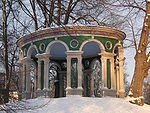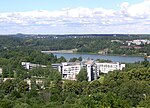Haga Palace Ruins

The Haga Palace Ruins (Swedish: Haga slottsgrund or Swedish: Stora Haga slottsruin) are the remnants of King Gustav III's ambitious vision for a grand and opulent palace in Hagaparken (Haga Park). Known as the Haga Great Palace (Swedish: Haga slottsgrund), the ruins are located in Solna Municipality, just north of Stockholm, Sweden. Construction began in 1786 with the laying of the foundation stone. The project, involving no fewer than six architects, was designed to create a magnificent palace where the king could retreat for leisure and display his prized collection of antique Roman statues. The palace was also intended to house an extensive gallery celebrating art and nature. However, the construction came to an abrupt halt in 1792, following the Assassination of Gustav III, leaving the palace incomplete. Today, the only surviving elements of this grand vision are the cellar foundations, partially concealed on a hill in Haga Park. These ruins include imposing stone walls and archways, evoking a sense of what might have been. The site, long a hidden gem, has become a favoured spot for locals who climb the central column or gather around small fires, surrounded by the thick, weathered stone walls.
Excerpt from the Wikipedia article Haga Palace Ruins (License: CC BY-SA 3.0, Authors, Images).Haga Palace Ruins
Frösundaviks allé, Solna kommun
Geographical coordinates (GPS) Address External links Nearby Places Show on map
Geographical coordinates (GPS)
| Latitude | Longitude |
|---|---|
| N 59.364444444444 ° | E 18.035833333333 ° |
Address
Haga slottsruin
Frösundaviks allé
169 70 Solna kommun, Frösunda
Sweden
Open on Google Maps










